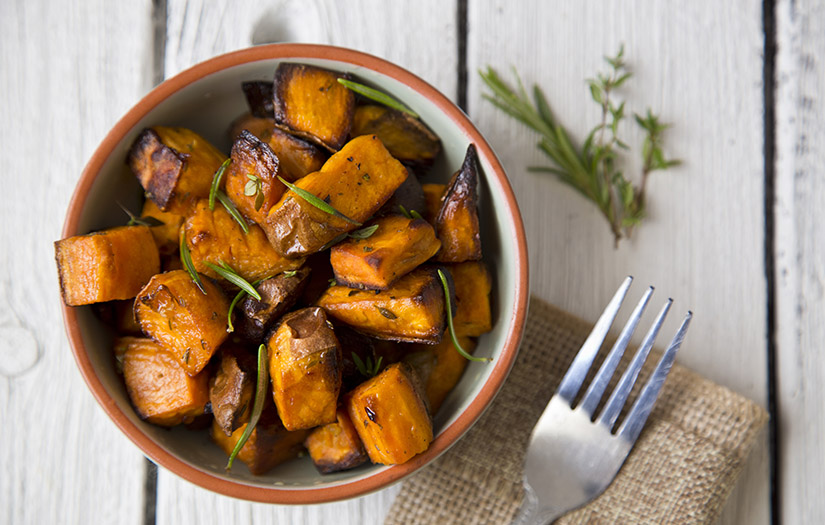The mere mention of sweet potatoes brings memories of a Thanksgiving table to mind. These nutritional tuberous all-stars have found their way onto everyday menus and, in some cases, have even bumped the traditional white potato out of our kitchens. What makes the sweet potato nutritionally different than their relegated white potato cousin? Are they really the better choice? Rated as one of the best vegetables you could eat, the sweet potato has versatility and some rather impressive nutritional benefits (1).
For all nutrition consultants out there, keep this information in mind the next time you are coaching clients on eating a balanced Thanksgiving meal.
Sweet Potato Nutrition Facts
A medium sweet potato (5 inches long, 2 inches in diameter, 130 g) based on the USDA’s National Nutrient Database for Standard Reference has the following nutritional breakdown:
Calories: 112
Protein: 2 g
Fat: 0.06 g
Carbs: 26 g
(Sugar/Fiber: 5/4 g)
They are also high in vitamins A and C, beta-carotene, manganese, potassium and antioxidants.
Compare it to a medium white potato (3 inches diameter, 213 g) that has the following approximate values:
Calories: 147
Protein: 3.6 g
Fat: 0.21 g
Carbs: 33.5 g
(Sugar/Fiber: 2.5/5 g)
White potatoes are also a good source of potassium, but are also higher overall in calories and total carbs.
A yam is a sweet potato but a sweet potato is not a yam.
Sweet Potato Glycemic Index: Why Potatoes Got Their Bad Reputation
A sweet potato (baked) has only a medium GI score of 64. A recent study by Allen, Corbitt, Maloney, Butt, & Truong (2012), evaluated how cooking and preparation techniques could potentially impact the GI score of sweet potatoes. They found that steaming, baking, and microwaving produced average GI scores of 63, 64, and 66, respectively.
When dehydrated or raw, these dropped to low GI scores of 40 and 28, respectively. What was even more interesting in this study was the effect caiapo, a commercial extract from the sweet potato cortex, had on lowering the glycemic index of the white potato to the same level as the raw sweet potato peel (3). (For more on the glycemic index.)
The Glycemic Index (GI) classifies foods on a scale of zero to 100 on their potential to raise blood glucose levels. Foods with a higher GI trigger a sharp surge and then a quick decline in blood glucose, while a low GI food has a slower climb and more modest changes (2).
A low glycemic index is considered 55 or less, medium from 56-69, and high is 70 or more. Focusing diets on lower GI foods may decrease the risk for developing type 2 diabetes, some cancers, and heart disease(2).
Preparation Methods
Now that you’ve learned the sweet potato’s nutritional details, are you ready to bite into one? Here are some sweet potato preparation tips taken from SweetPotatoUSA.org to get you started on your own healthy creations.
First thing you’ll want to do is scrub the skins, trim the ends, and cut out any bruised spots. Use a stainless steel knife to prevent the sweet potato from darkening.
Bake: Prick the potato several times with a fork and bake at 400° F for 40 to 50 minutes or until tender.
Microwave: Prick the potato several times and microwave on high power for 4 to 6 minutes or until tender. Turn halfway through cooking time.
Steam: Bring 1 1/2 inches of water to a boil. Place whole, unpeeled sweet potatoes in steamer basket, cover and steam for 40 to 50 minutes or until tender.
Boil: Place whole sweet potatoes in boiling water and cook until tender, about 35 to 40 minutes.
Sauté: Peel and cut into 1/4- to 1/2- inch thick slices or 1- inch cubes. Place pieces and 2 tablespoons butter or oil in a large skillet and cook, stirring frequently, over medium-high heat until tender.
Grill: Slice lengthwise into 1/4-inch thick slices. Place on grill. Turn once. Remove when tender.
Fresh: Peel and cut into sticks and serve with your favorite dip. Immediately rinse and place cut sweet potatoes in ice water or in a plastic bag with ice and refrigerate until ready to serve.
Even though they taste fantastic, don’t be swayed into thinking that sweet potato fries are really a healthier alternative to traditional fries!
Are you currently on a learning streak? Check out some free mini courses on nutrition here.
References
- 10 Worst and Best Foods. Nutrition Action Health Letter 2009 Center for Science in the Public Interest. www.cspinet.org/nah/10foods_bad.html.
- Insel P., Ross D., McMahon K., et al. Nutrition. 4th ed. Sudbury, MA: Jones and Bartlett; 2011.
- Allen, J., Corbitt, A., Maloney, K., Butt, M., Truong, V. 2012. Glycemic index of sweet potato as affected by cooking methods. Open Nutrition Journal. 6:1-11.
















